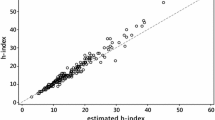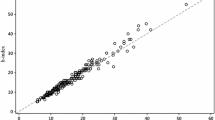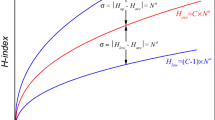Abstract
We propose new variations of the standard and the real-valued (or interpolated) h-index. More precisely, we propose two different types. For the first type, sources are years, and items are either publications, or citations received or citations per publication. The second type makes use of the speed by which citations are received: it is a diffusion speed index.
Similar content being viewed by others
References
Alonso, S., Cabrerizo, F. J., Herrera-Viedma, E., & Herrera, F. (2009). h-Index: A review focused in its variants, computation and standardization for different scientific fields. Journal of Informetrics, 3, 273–289.
Bouyssou, D., & Marchant, T. (2010). Consistent bibliometric rankings of authors and of journals. Journal of Informetrics, 4(3), 365–378.
Bouyssou, D., & Marchant, T. (2011a). Bibliometric rankings of journals based on impact factors: An axiomatic approach. Journal of Informetrics, 5(1), 75–86.
Bouyssou, D., & Marchant, T. (2011b). Ranking scientists and departments in a consistent manner. Journal of the American Society for Information Science and Technology, 62(9), 1761–1769.
Braun, T., Glänzel, W., & Schubert, A. (2005). A Hirsch-type index for journals. The Scientist, 19(22), 8.
Braun, T., Glänzel, W., & Schubert, A. (2006). A Hirsch-type index for journals. Scientometrics, 69, 169–173.
Burrell, Q. L. (2007). On the h-index, the size of the Hirsch core and Jin’s A-index. Journal of Informetrics, 1(2), 170–177.
Egghe, L. (2006a). An improvement of the H-index: The G-index. ISSI Newsletter, 2(1), 8–9.
Egghe, L. (2006b). Theory and practice of the g-index. Scientometrics, 69(1), 131–152.
Egghe, L. (2010). The Hirsch index and related impact measures. Annual Review of Information Science and Technology, 44, 65–114. Information Today Inc., Medford, NJ.
Egghe, L., Bornmann, L., & Guns, R. (2011). A proposal or a first-citation speed index. Journal of Informetrics, 5(1), 181–186.
Frandsen, T. F., Rousseau, R., & Rowlands, I. (2006). Diffusion factors. Journal of Documentation, 62(1), 58–72.
Guns, R., & Rousseau, R. (2009). Real and rational variants of the h-index and the g-index. Journal of Informetrics, 3(1), 64–71.
Hirsch, J. E. (2005). An index to quantify an individual’s scientific research output. Proceedings of the National Academy of Sciences of the USA, 102(46), 16569–16572.
Jin, B. H. (2007). The AR-index: Complementing the h-index. ISSI Newsletter, 3(1), 6.
Jin, B. H., Liang, L. M., Rousseau, R., & Egghe, L. (2007). The R- and AR-indices: Complementing the h-index. Chinese Science Bulletin, 52, 855–863.
Liang, L. M., & Rousseau, R. (2009). A general approach to citation analysis and an h-Index based on the standard impact factor framework. In B. Larsen & J Leta (Eds.), ISSI 2009; 12th international conference on scientometrics and informetrics (pp. 143–153). Rio de Janeiro: BIREME & Federal University of Rio de Janeiro.
Liu, Y. X. (2011). The diffusion of scientific ideas in time and indicators for the description of this process (Doctoral thesis). Antwerp: University of Antwerp.
Liu, Y. X., & Rousseau, R. (2008). Definitions of time series in citation analysis with special attention to the h-index. Journal of Informetrics, 2(3), 202–210.
Mahbuba, D. (2012). An informetric analysis of the scientific production of Bangladesh (Doctoral thesis). Antwerp: University of Antwerp.
Mahbuba, D., & Rousseau, R. (2012). A diffusion-based h-type indicator. In E. Archambault, Y. Gingras & V. Larivière (Eds.), Proceedings of STI 2012 Montréal (pp. 877–878). Montréal, QC: Science-Metrix, Observatoire des Sciences et des Technologies.
Marchant, T. (2009). An axiomatic characterization of the ranking based on the h-index and some other bibliometric rankings of authors. Scientometrics, 80(2), 325–342.
Rousseau, R. (2006). Simple models and the corresponding h- and g-index. E-LIS: ID 6153. Available at: http://hdl.handle.net/10760/7501.
Rousseau, R. (2008). Reflections on recent developments of the h-index and h-type indices. COLLNET Journal of Scientometrics and Information Management, 2(1), 1–8.
Rousseau, R. (2010). Ci-speed: A Hirsch-type citation speed index for a set of articles. ISSI Newsletter, 6(3), 62–65.
Rousseau, R., & Jin, B. H. (2008). The age-dependent h-type AR²-index: basic properties and a case study. Journal of the American Society for Information Science and Technology, 59(14), 2305–2311.
Rousseau, R., Guns, R., & Liu, YX. (2008). The h-index of a conglomerate. Cybermetrics, 12(1): Paper 2. Retrieved from http://cybermetrics.cindoc.csic.es/articles/v12i1p2.html.
Rousseau, R., & Ye, F. Y. (2012). Basic independence axioms for the publication-citation system. Journal of Scientometric Research, 1(1), 22–27.
Rowlands, I. (2002). Journal diffusion factors: A new approach to measuring research influence. Aslib Proceedings, 54(2), 77–84.
Waltman, L., & van Eck, N. J. (2012). The inconsistency of the h-index. Journal of the American Society for Information Science and Technology, 63(2), 406–415.
Acknowledgments
The authors thank Raf Guns (UA) for useful remarks, improving their research.
Author information
Authors and Affiliations
Corresponding author
Rights and permissions
About this article
Cite this article
Mahbuba, D., Rousseau, R. Year-based h-type indicators. Scientometrics 96, 785–797 (2013). https://doi.org/10.1007/s11192-012-0934-z
Received:
Published:
Issue Date:
DOI: https://doi.org/10.1007/s11192-012-0934-z




